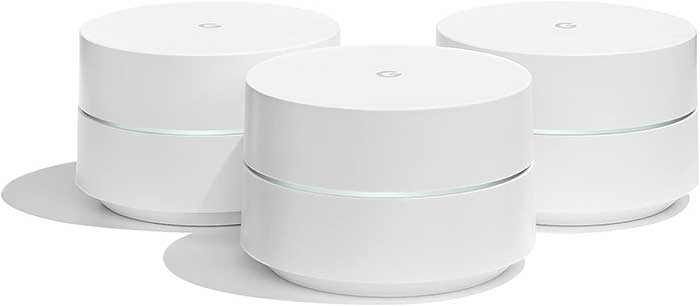Exploring the reach of the WiFi signal is something most of us have done at least once. In the past, it was normal to walk around the house and suddenly lose the connection. But now, we have solutions such as Google WiFi that provide seamless coverage throughout the home.
The question we’re here to answer is how far apart can Google WiFi points be without disrupting functionality. To answer the question, we need to discuss what Google Wi-Fi is and how it works first.
CONTENTS
What Is Google WiFi?

To define what Google WiFi is, we need to define what a home mesh wireless network is. Meshnet (mesh network) is a type of network where all the points communicate with each other dynamically and directly.
Every piece of the network that communicates, i.e. every meshnet point, can relay information to other pieces. It comes in handy when we need more access points across our home, and we want a good signal.
How Does Google WiFi Work?
It’s a fair question, and the simple answer is that Google WiFi, like any other mesh wireless network, uses WiFi points to establish a strong connection and a secure wireless network across our home.
The wireless signal travels from one Google WiFi point to the other. The more points we have in our home, the more coverage we get. There’s no order of points when it comes to signal transmission because it travels simultaneously between all points.
How to Set Up Google WiFi?
To set up Google WiFi, we need to install the Google Home app. Once we open the app, it will automatically start scanning for smart devices. So, it’s going to connect to all the smart devices like Google TV, a camera, a display, etc.
Using Google Home
If you’ve plugged in your Google WiFi points, it should find them easily, but you need to choose the location of your points carefully. Also, you can use any point as the primary one, and you need to connect it to the modem for internet access.

Once you’ve connected the first point to the modem and turned it on, you need to wait a minute and a half for it to be available in the Google Home app. Once the blue light starts blinking slowly, you can open the app.
Click on Add, and then click on Set up device. It’s going to be New device and you need to select your home. Once you click on Yes, you should scan the QR code of the point. Finally, follow the prompts to finish the setup and your WiFi is going to be available.
Adding and Positioning Points
Adding the other points is easy, just follow the same steps and instructions in the app to finish the setup. The setup should tell you how far apart can Google WiFi points be if you place them further apart.
Now, the app usually recommends placing the Google WiFi points no more than 30 feet apart (approx. 10 meters). However, we recommend positioning them even closer for a better signal across your home.
If you’re looking for the best performance of your WiFi points, you can always connect them with wires. This is going to provide better wireless functionality as well, but in this case, the points need to be approximately 3 meters apart (cable range).
Improving WiFi Speed?
If you’ve done everything right, and if you’ve gone through the setup correctly, everything should work fine. However, sometimes it takes more than placing the Google WiFi points in good positions to achieve a good speed. In that case, we can:
- Stop device connection: There’s an option in the Google Home app to pause a connection for a specific device. We just need to select Wi-Fi and go to Devices. There’s going to be Pause next to the device we want to pause, so just tap on that.
When you feel confident that that’s not the device responsible for slow internet speeds, you can go back to the same menu and simply tap on Unpause. Try checking the other devices and if your connection improves when you pause them.
- Move the device closer: The main reason our internet speed might be low is that we’re too far from one of the Google points. So, the logical thing to do is get closer for a better connection. This is usually the answer for wireless connectivity.
- Test speed: It’s always good to test your internet speed. If you figure out that the speed is much lower than the one your ISP (Internet Service Provider) promised you, you might need to contact them and see what the reason for this is.
- Restart the network: Almost always the answer, a good old-fashioned restart. Just turn off all the devices on your network. Then, turn on the modem first and wait for all the LEDs to turn back on.
Once all of them are steady, you can start connecting Google WiFi points. Connect your primary Google WiFi point to the modem via cable, and then turn it on. Go through the setup steps in the app if necessary.
Recommended Reading:
- Chromecast Orange Light: How To Fix It In Minutes
- Google Fiber Network Box Blinking Red
- Google Wi-Fi Flashing Red: Here’s What to Do
- Google Wi-Fi Flashing Orange: How To Fix It In Minutes
Conclusion
So, the answer to how far apart can Google WiFi points be is approximately 30 feet, but we do recommend a wired connection between the points for best performance. This means that the distance should be up to 10 feet.
If you experience any trouble with the Google WiFi system, they have an excellent support forum that guides you through different troubleshooting steps. Also, start with the network restart when an issue arises, this usually fixes it.

Hey, I’m David. I’ve been working as a wireless network engineer and a network administrator for 15 years. During my studies, I also worked as an ISP field technician – that’s when I met Jeremy.
I hold a bachelor’s degree in network engineering and a master’s degree in computer science and engineering. I’m also a Cisco-certified service provider.
In my professional career, I worked for router/modem manufacturers and internet providers. I like to think that I’m good at explaining network-related issues in simple terms. That’s exactly what I’m doing on this website – I’m making simple and easy-to-follow guides on how to install, set up, and troubleshoot your networking hardware. I also review new network equipment – modems, gateways, switches, routers, extenders, mesh systems, cables, etc.
My goal is to help regular users with their everyday network issues, educate them, and make them less scared of their equipment. In my articles, you can find tips on what to look for when buying new networking hardware, and how to adjust your network settings to get the most out of your wi-fi.
Since my work is closely related to computers, servers, and other network equipment, I like to spend most of my spare time outdoors. When I want to blow off some steam, I like to ride my bike. I also love hiking and swimming. When I need to calm down and clear my mind, my go-to activity is fishing.
